As we navigate the digital age, technology continues to reshape our lives in unprecedented ways. One of the sectors experiencing a significant transformation is healthcare, with telehealth app development leading the charge. These innovative digital platforms are revolutionizing healthcare delivery, making it more accessible, efficient, and patient-centric.
This article will delve into the fascinating world of telehealth apps, exploring their benefits, features, and the immense potential they hold for the future of the healthcare industry. Let’s delve in!
Decoding Telehealth Apps
Telehealth apps, also known as telemedicine apps, are digital platforms that use technology to facilitate remote healthcare services. They serve as a virtual bridge between patients and healthcare professionals, enabling a range of services, including virtual consultations, health monitoring, patient data management, and digital prescription of medication.
By eliminating geographical barriers, these apps democratize access to healthcare services, ensuring that quality healthcare is within everyone’s reach, irrespective of their location.
The Multifaceted Benefits of Telehealth Apps
Telehealth apps offer a plethora of benefits that are transforming the healthcare landscape. Let’s delve into some of these benefits:
Accessibility
One of the most significant benefits of telehealth apps is their ability to make healthcare services accessible to a wider audience. This is especially beneficial for individuals residing in remote areas where healthcare facilities are scarce or non-existent.
By offering the ability to consult with medical professionals virtually, these apps ensure that everyone, regardless of their location, can access healthcare services.
Convenience
The convenience offered by telehealth apps is unparalleled. Patients no longer need to travel long distances or wait in long queues to consult with healthcare professionals. With these apps, they can schedule appointments at their convenience and receive medical advice from the comfort of their homes. This not only saves time but also reduces the stress associated with hospital visits.
Cost-Effectiveness
Telehealth apps are also cost-effective. They eliminate travel and related expenses for patients, making healthcare services more affordable.
On the other hand, healthcare providers can reduce overhead costs associated with maintaining physical facilities, leading to significant savings.
Enhanced Patient Engagement
Telehealth apps are equipped with features that foster greater patient engagement. They allow patients to track their health data, schedule appointments, and communicate with healthcare providers, enabling them to play a more active role in their healthcare journey.
This increased engagement leads to better health outcomes and improved patient satisfaction.
Key Features of Telehealth Apps
Telehealth apps come equipped with a host of features designed to streamline the healthcare delivery process.
These features are aimed at enhancing the patient experience and improving the efficiency of healthcare providers.
- Virtual Consultations: This feature enables patients to have video consultations with healthcare providers. It allows patients to receive medical advice without any physical contact, making healthcare services safer, especially in times of pandemics.
- Appointment Scheduling: Telehealth apps often come with an integrated appointment scheduling system. This feature allows patients to book, reschedule, or cancel appointments with ease, offering them greater control over their healthcare journey.
- Prescription and Medication Management: Some telehealth apps offer a prescription management feature. This enables healthcare providers to prescribe medication digitally, eliminating the need for physical prescriptions and making the process more efficient.
- Health Monitoring: Many telehealth apps come with health monitoring features. These allow patients to track vital health parameters such as blood pressure, heart rate, and glucose levels, helping them stay on top of their health.
- Secure Messaging: Telehealth apps also offer secure messaging features. This allows for secure communication between patients and healthcare providers, ensuring that all conversations remain private and confidential.
The Immense Potential of Telehealth Apps
The potential of telehealth apps extends far beyond the features they currently offer. As technology continues to evolve, these apps are expected to become more sophisticated, offering a wider range of services and improving patient outcomes.
Artificial intelligence (AI) and machine learning are two technologies that hold immense promise for the future of telehealth apps. With these technologies, telehealth apps can provide predictive analysis, personalized treatment plans, and improved diagnostic accuracy. They can also automate routine tasks, freeing up healthcare service providers to focus on more critical aspects of patient care.
Moreover, the integration of telehealth apps with wearable devices and IoT can revolutionize health monitoring. By continuously tracking health parameters, these apps can provide real-time health insights, enabling early detection of potential health issues and timely intervention.
The Future of Healthcare with Telehealth Apps
Telehealth apps are not just a trend; they are the future of healthcare. They are transforming the way healthcare services are delivered, making them more accessible, efficient, and patient-centric. As these apps continue to evolve, they’ll play a critical role in shaping the future of healthcare.
In the future, healthcare will be at our fingertips. We will be able to consult with healthcare professionals from the comfort of our homes, monitor our health in real-time, and receive personalized treatment plans based on our health data.
This future is not far off; it is already being realized through the innovative telehealth apps available today.
Embracing the Future with Kiwi Health
Telehealth apps are revolutionizing healthcare delivery, making it more accessible, efficient, and patient-centric.
The revolution in healthcare delivery is here, and it’s being led by telehealth apps. As we move forward, these apps will continue to play a crucial role in shaping the future of healthcare.
With the help of these technologies, we may create a healthcare system that is more accessible, more efficient, and more patient-centric. The future of healthcare is here, and it’s digital!

Leave a Reply